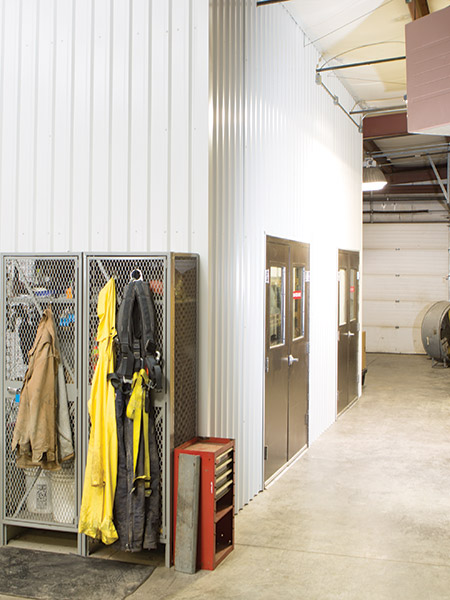Extending Equipment Life with Cleaner Oil
Improved Oil Storage and Handling Produce Cost Savings at Bunge
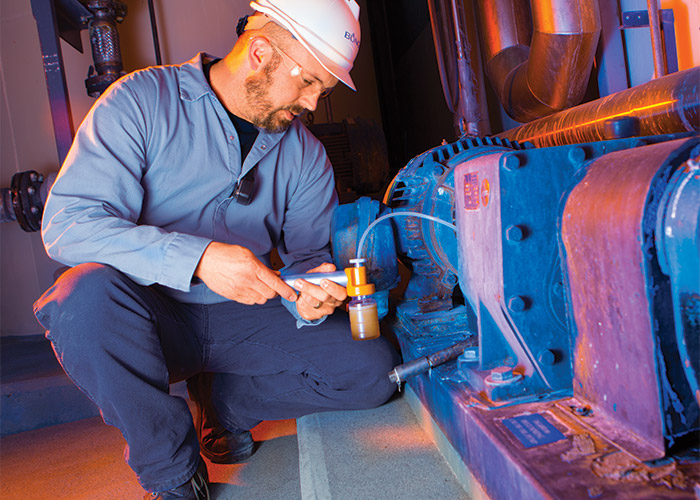
Excellence in every aspect of business is the daily goal at Bunge, a global agribusiness and food ingredient company. Essential to this effort is the organization’s asset reliability and reporting optimization program (ARROP). Among the most important components of this program are monitoring and improving how equipment is maintained, including handling and storage of machine lubricants.
When Bunge started developing a world-class maintenance program, it identified the need to evaluate oil from its arrival at the plant to its placement in a machine. Root cause analysis began indicating bearing failure due to contaminated oil as the cause of breakdowns. The new predictive oil analysis practices also detected poor-quality oil in samples. Bunge’s maintenance team researched how to correct these issues and soon discovered that equipment to properly filter and store oil before use was a necessity to keep machines running longer and more efficiently.
Identified Need
Once it was determined that dirty oil was causing breakdowns, the entire oil handling procedure was evaluated. In March 2012, maintenance manager Tony Chavez and maintenance technician Andy Burge received training from Noria and obtained Level I Machine Lubrication Technician certification from the International Council for Machinery Lubrication (ICML). This training revealed that most new oil did not meet the cleanliness specifications necessary for equipment and that contaminants entered the oil through multiple streams. Oil was already dirty in incoming barrels, collected dust and dirt particles during transport from storage to the point of use, was cross-contaminated from using the same container to transport different grades of oil, and collected additional contaminants through equipment ventilation points.
Bunge’s ARROP program implemented regular oil analysis, which discovered that oil in the equipment was just as contaminated after an oil change as it was before. The lubricant viscosity after an oil change was also the same as before, indicating the new oil was already out of the acceptable viscosity range. Initially, Bunge didn’t want to test oil directly from the barrels as they arrived due to the belief that new oil should be ready for use. However, after the Noria training, the plant tested the new oil and found that it did not meet the cleanliness standards. After sampling the new oil several times, Bunge decided to filter it for two hours, which allowed the oil to cycle about seven times.
The plant’s ISO viscosity grade (VG) 220 and 320 oil did not meet the cleanliness standards that were developed with input from Noria. The standard for the ISO VG 320 oil was initially set at an ISO code of 17/15/12, but Bunge was unable to achieve this cleanliness level even after several hours of filtering the oil. The new standard was set at 18/16/13. However, the plant was able to filter the ISO VG 220 oil to 17/15/12 within just a few hours.
When oil analysis was first performed, there were several instances when the plant’s anti-wear (AW) 68 oil had a viscosity of 71 to 74. This was above the 10-percent allowance for the viscosity tolerance. Even when the oil was changed, the next sample came back with high viscosity.
One sample of new oil that was received had too much water and particulate matter, resulting in the rejection of the drum. The drum was immediately brought inside, where filtration began. The maintenance technician noticed that the fill date was several months old and that water was standing on top of the drum. He also observed that the drum was very dirty compared to the others. The sample came back with excessive particle counts in silicon as well as water. Rather than spending time and money trying to make this oil acceptable, Bunge contacted the supplier and sent copies of the oil analysis along with the drum number and fill date. The supplier took back the drum and sent a new one the next day.
Bunge also recognized the need to improve oil identification and separation. It was recommended that the drums of food-grade and non-food-grade lubricants be separated within the storage area. To assist in separating different oils, it was necessary to properly label each drum based on the type of oil it contained.





Oil Storage Approach
After all of the issues with shipping drums, Bunge needed a way to store oil in other containers. The plant challenged Burge to find storage equipment that would be consistent with his Nori a training. In his research, he found several systems that would meet the cleanliness criteria. This equipment included containers for transporting oil, a storage and filtering system, and the proper color-identification system for oils. The transporting containers and bulk storage system matched nicely with the color-coding system. They even adopted the plant’s shape coding for labeling the bulk storage tanks.
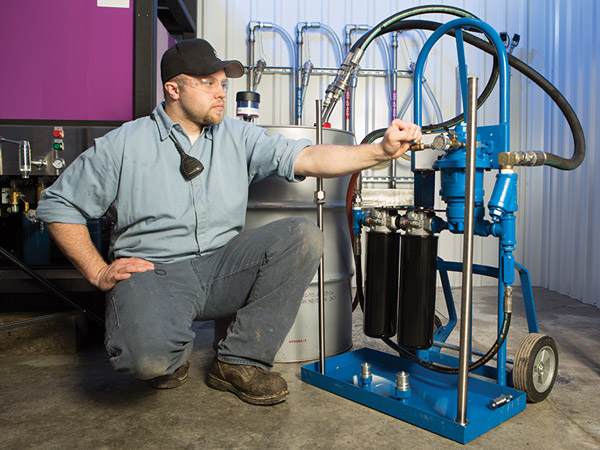 Bunge also had to consider the size of these storage tanks. The plant reviewed its annual usage of each oil grade to determine how much would need to be kept on hand and which containers would hold the appropriate amount.
Bunge also had to consider the size of these storage tanks. The plant reviewed its annual usage of each oil grade to determine how much would need to be kept on hand and which containers would hold the appropriate amount.
The filter size and capacity for each type of oil also had to be researched. Because of the different viscosity levels of each oil being filtered and because only one pump was used for the filtering system, Bunge had to establish the proper beta and micron ratings for the filters to ensure that the plant would be meeting its cleanliness specifications for each grade of oil.
Next, an effective method for filtering oil from the drums into the bulk storage system had to be identified. The plant’s filter cart is used in multiple areas, and because there are areas rated for dust and gases in the air, it had to meet certain requirements. Bunge chose an air-powered pump and went through two versions before finding the right size of filters to achieve an acceptable flow rate.
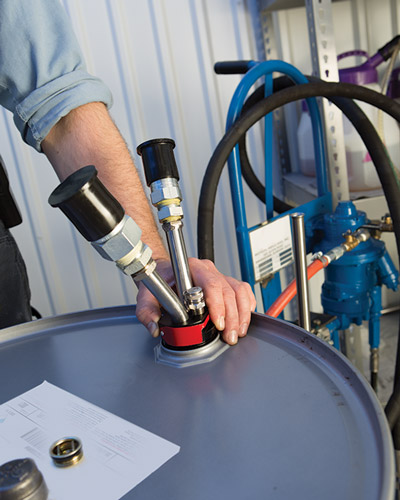 Another storage consideration was having a means of filtering into, out of and through bulk storage. Therefore, the oil would be filtered at every storage or transfer point all the way until it meets the machine.
Another storage consideration was having a means of filtering into, out of and through bulk storage. Therefore, the oil would be filtered at every storage or transfer point all the way until it meets the machine.
Aside from filtering contaminants from the oil, Bunge needed a way to eliminate other contaminant streams. One method was to protect oil containers from dust and dirt in the environment as well as from temperature changes. The plant determined a designated clean room would be necessary. This room could be positively pressurized to prevent dirt from entering. This would be achieved by a fan blowing filtered air into the room at a faster rate than it would blow out of the room with the doors open. An open door would allow the positive pressure to escape the room toward the area of lower air pressure.
Within this room, transport containers could be kept clean and organized on a racking system, and oils could be separated by grade using color and shape codes. Shapes would be included to account for color blindness. The combined codes would offer a visual representation of which grade of oil was being used. All points of use could also be labeled with the same color and shape code system.
To ensure the oil remained clean every step of the way, Bunge needed an improved method of transporting oil to its end use. The plant selected top-port containers with closable spouts to prevent contaminants from entering during transportation. A routine schedule for cleaning these containers was also developed.

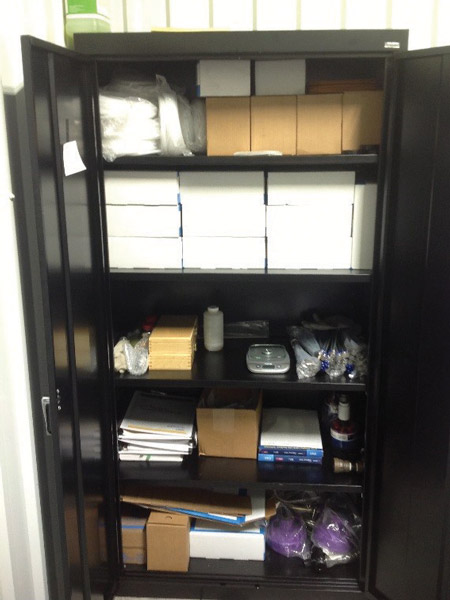
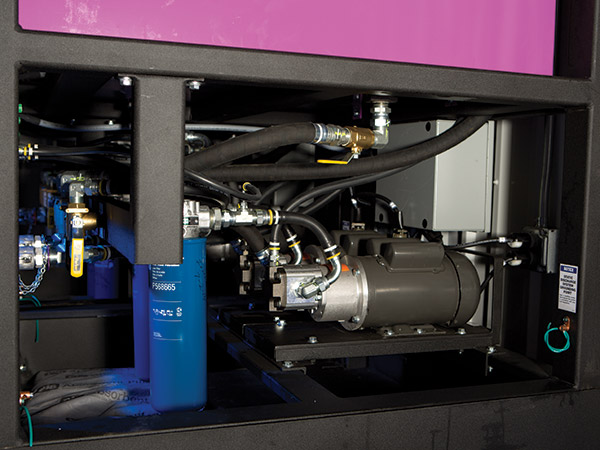
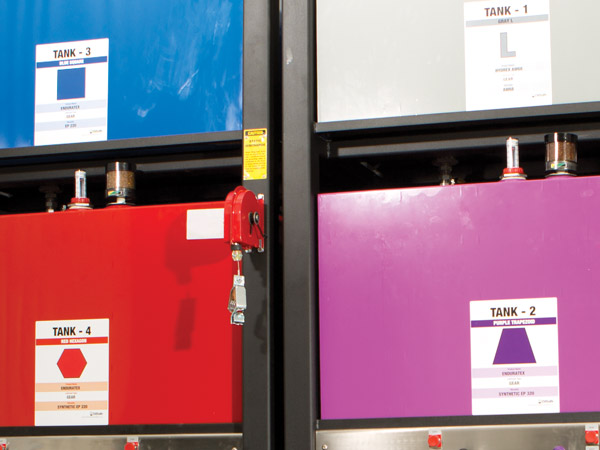
Completing the Project
To prepare for the possibility of constructing a clean oil storage room, the plant collected quotes from various suppliers. The expenditure would also need to be justified by reviewing the cost of equipment downtime, constantly replacing oil and equipment failure due to lack of proper lubrication.
During this cost evaluation, Bunge had to decide whether this project could fit within the capital budget. It chose to move forward with the clean room because the rate of return was sufficient enough to be absorbed into the maintenance cost. The actual cost of the project would vary depending upon geographic location, building space, equipment need and other factors. Research for the project began in August 2013. Construction started in November 2013, and the project was completed in April 2014.
Now, not only does Bunge have a clean, organized storage area and proper ways of handling its oil, but it also saves a considerable amount of time and money not changing oil and replacing equipment that fails due to poor-quality oil. The plant can also foresee the approximate amount of oil that will be needed ahead of time. Routine predictive oil analysis indicates oil quality in the equipment and determines if and when the oil should be changed to prevent damage to machinery. Cleaner oil keeps the plant running better and longer.
Bunge’s maintenance team is constantly moving toward best practices and knows that without a means to protect the oil, it could never achieve world-class status.

